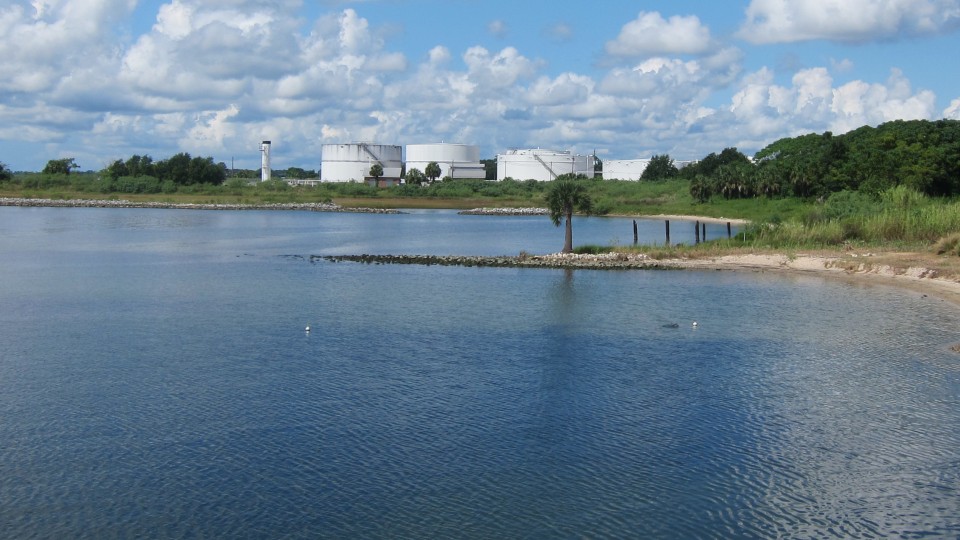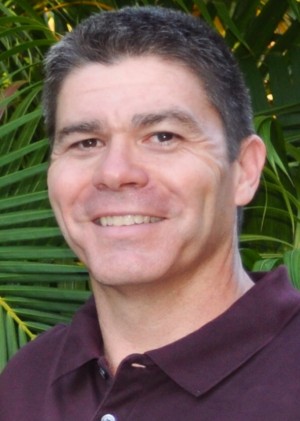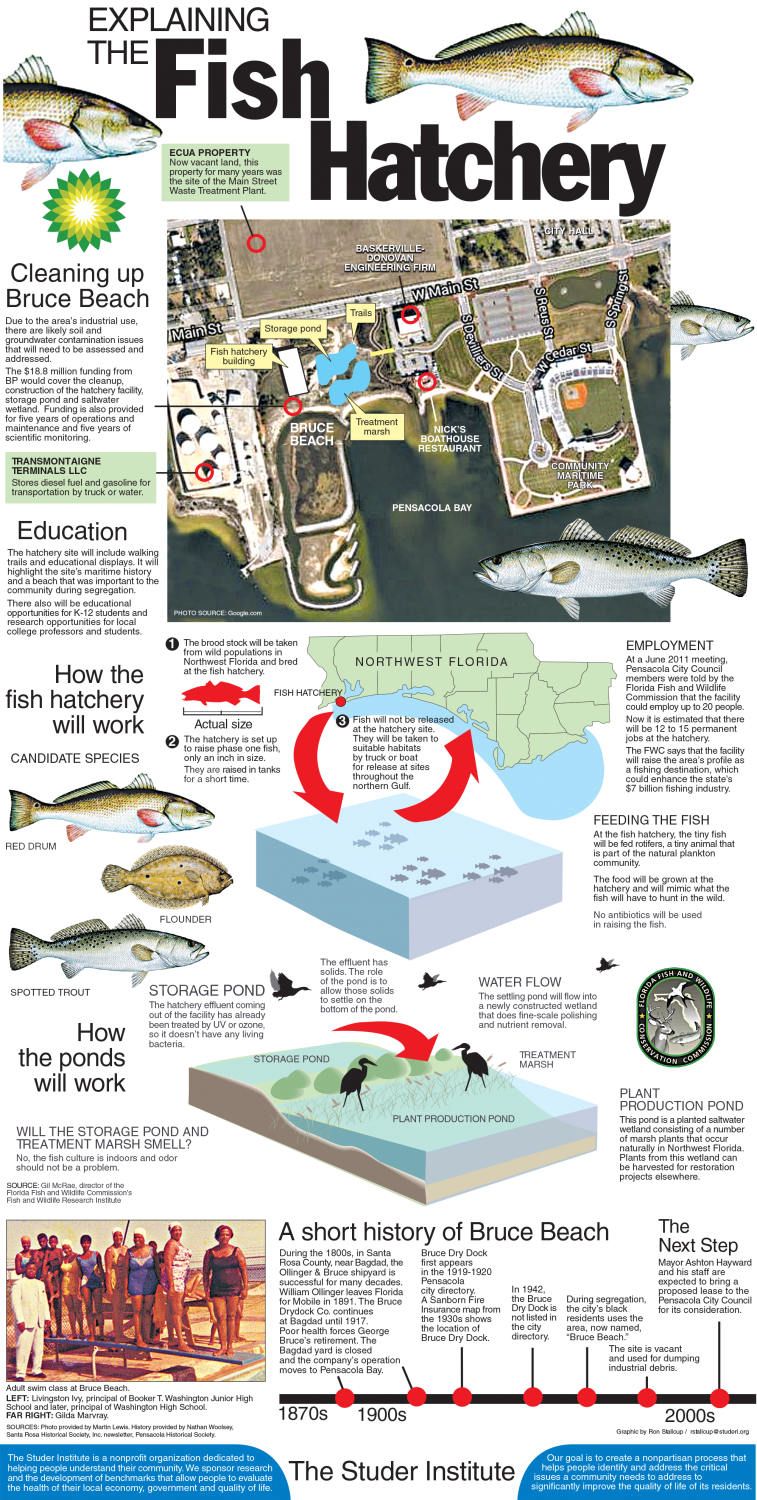Bruce Beach hatchery project moving forward
- September 4, 2015
- / Louis Cooper
- / community-dashboard

Bruce Beach will be the site of an $18.8 million Florida Gulf Coast Fisheries Enhancement Center. The funds come from BP as part of restoraton from the 2010 Deepwater Horizon spill. Photo credit: Shannon Nickinson
The state soon will begin accepting bids for Florida’s first saltwater production hatchery to be located on the Pensacola waterfront at Bruce Beach.
The hatchery will be paid for with $18.8 million in Natural Resource Damage Assessment funds – among the first money paid by BP to correct damage done by the 2010 Deepwater Horizon oil spill. (Click here for a graphic describing how BP money has been allocated so far.)
“The intent is to pay back loss to recreational angling opportunities that happened as a result of the spill,” said Gil McRae, director of the Florida Fish and Wildlife Conservation Commission’s Fish and Wildlife Research Institute. “The goal is to raise and stock species of fish that are targeted by recreational anglers.”
The recreational fishing industry is an important part of the region’s tourism economy, though while the fish will be hatched in Pensacola, they won’t be released locally. They will be released in the waters throughout the northern Gulf in Florida, though McRae has said no further east than Apalachicola Bay.
“The project is 100 percent go,” McRae said.
The hatchery, to be called the Florida Gulf Coast Fisheries Enhancement Center, will be located on Bruce Beach, a site that was once a dry dock, a segregated beach park, and, most recently, a de facto construction debris dump site.
The BP money will cover the cost to design and build the facility and operate it for five years. After that, the FWC will fund the facility.
“We had a significant amount of upfront work to do to make sure we weren’t going to run into any surprises on the site,” he said. “Now, we have prepared the bid for the design and engineering components of the project.”
That upfront work included a cultural survey to make sure there weren’t any historical artifacts on the site, a protected species survey and a soil analysis to make sure there was no serious contamination at the site.
Pensacola Mayor Ashton Hayward, a longtime proponent of the hatchery, did not respond to a request to his office for comment on the progress of the hatchery. The city’s website site has a section for information about the project, linked here.
McRae expects the request for bids will be posted some time in September. Construction could begin as soon as late 2016, with the facility open by early 2018.
A “future home of” sign should be in place in the next month.
Research, educational components part of the plan
The hatchery will concentrate on inshore species sought by local anglers, possibly including red drum, sea trout and southern flounder.
The facility, which will employ 12 to 15 people, will be unique in Florida.
“The only other saltwater hatchery we have is a small research facility down in Manatee County,” McRae said. “This will be the first saltwater hatchery of an appropriate scale to do wide-scale raising and releasing of fish.”
While the main goal of the hatchery is to replace fish lost to the spill, there are broader components, as well.
“We hope it’s an asset to the community and helps link together the other components of the waterfront downtown to make a much more community friendly coastal area for the city,” he said.
“The intent is to have public access. We haven’t decided whether it will be scheduled or open for folks to just walk in. Certainly, education, outreach and public access to the facility is part of our planning.”
In April of 2014, McRae said the Institute would be willing to work with the University of West Florida and others about expanding research opportunities into areas like water quality, habitat work and getting college students hands-on experience.
“We intend to develop research programs beyond the hatchery elements whenever opportunity allows throughout the life of the facility,” McRae said then. “We can bring whatever other research the local partners are interested in engaging in as long as we meet our hatchery obligations.”
McRae cited the growth of the Marine Research Institute at Jacksonville University as an example of the way the Pensacola facility’s footprint could grow.
That possibility was one of the things that Keith Wilkins, the county’s neighborhood and environmental services director and Chips Kirschenfeld, senior scientist and divison manager of the water quality and land management division of the county, found exciting about the project.
Wilkins said in 2014 that the Institute’s involvement adds flexibility in terms of the educational development of the site. They could do research, for example, on what species will predate on lionfish to control that population or research that couples in with high schools, undergraduates or graduate students, Wilkins said.


 CivicCon launches with a look at good growth in cities
CivicCon launches with a look at good growth in cities
 Building stronger brains one baby, one parent at a time
Building stronger brains one baby, one parent at a time
 SCI debuts commercial on Early Learning City
SCI debuts commercial on Early Learning City
 Entrecon: World class speakers and an opportunity to sharpen skills
Entrecon: World class speakers and an opportunity to sharpen skills
 PYP Quality of Life survey 2017
PYP Quality of Life survey 2017
 EntreCon Pensacola 2016: A look back
EntreCon Pensacola 2016: A look back
 Leadership tip: getting better employee takeaways
Leadership tip: getting better employee takeaways
 Leadership tip: be interested instead of interesting
Leadership tip: be interested instead of interesting
 Leadership tip: delivering difficult messages
Leadership tip: delivering difficult messages
 Brain Bags boost Arc, Early Childhood Court programs
Brain Bags boost Arc, Early Childhood Court programs